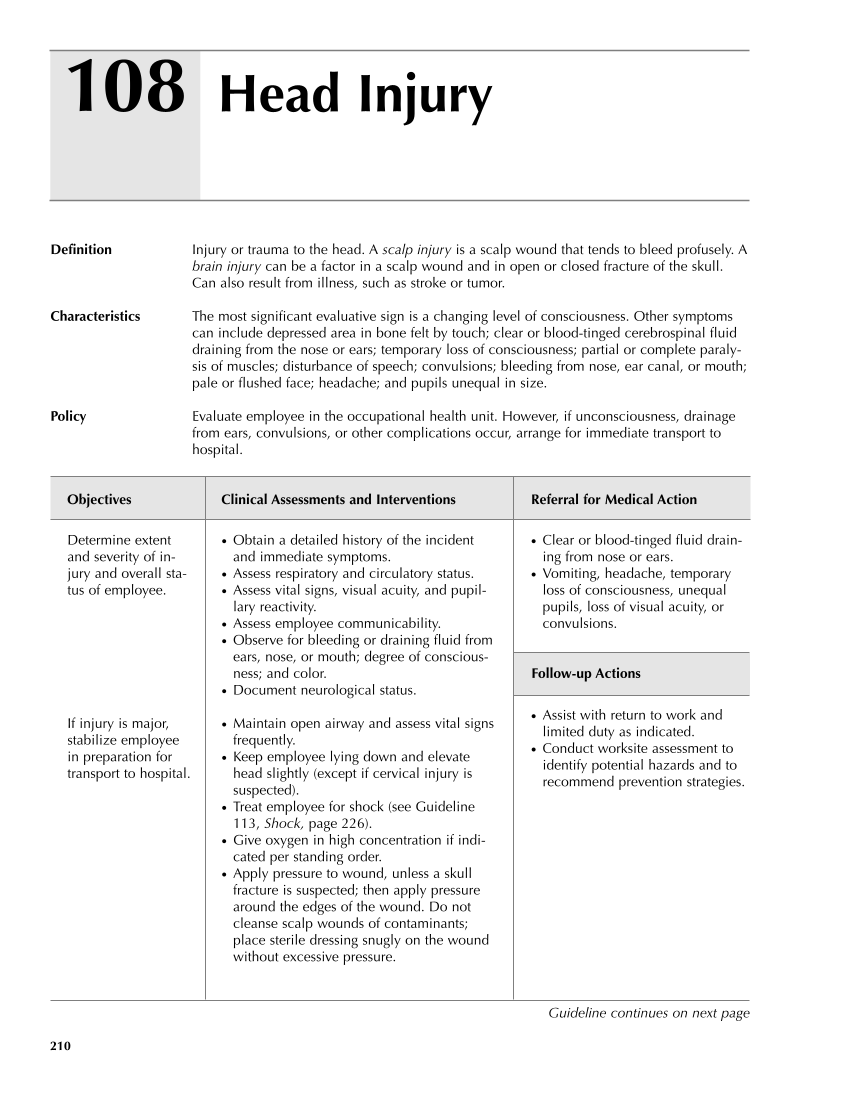108 210 Definition Injury or trauma to the head. A scalp injury is a scalp wound that tends to bleed profusely. A brain injury can be a factor in a scalp wound and in open or closed fracture of the skull. Can also result from illness, such as stroke or tumor. Characteristics The most significant evaluative sign is a changing level of consciousness. Other symptoms can include depressed area in bone felt by touch clear or blood-tinged cerebrospinal fluid draining from the nose or ears temporary loss of consciousness partial or complete paraly- sis of muscles disturbance of speech convulsions bleeding from nose, ear canal, or mouth pale or flushed face headache and pupils unequal in size. Policy Evaluate employee in the occupational health unit. However, if unconsciousness, drainage from ears, convulsions, or other complications occur, arrange for immediate transport to hospital. Objectives Clinical Assessments and Interventions Referral for Medical Action Head Injury ● Clear or blood-tinged fluid drain- ing from nose or ears. ● Vomiting, headache, temporary loss of consciousness, unequal pupils, loss of visual acuity, or convulsions. Follow-up Actions ● Assist with return to work and limited duty as indicated. ● Conduct worksite assessment to identify potential hazards and to recommend prevention strategies. Determine extent and severity of in- jury and overall sta- tus of employee. If injury is major, stabilize employee in preparation for transport to hospital. ● Obtain a detailed history of the incident and immediate symptoms. ● Assess respiratory and circulatory status. ● Assess vital signs, visual acuity, and pupil- lary reactivity. ● Assess employee communicability. ● Observe for bleeding or draining fluid from ears, nose, or mouth degree of conscious- ness and color. ● Document neurological status. ● Maintain open airway and assess vital signs frequently. ● Keep employee lying down and elevate head slightly (except if cervical injury is suspected). ● Treat employee for shock (see Guideline 113, Shock, page 226). ● Give oxygen in high concentration if indi- cated per standing order. ● Apply pressure to wound, unless a skull fracture is suspected then apply pressure around the edges of the wound. Do not cleanse scalp wounds of contaminants place sterile dressing snugly on the wound without excessive pressure. Guideline continues on next page
Purchased from OEM Press by (ge corporate access). (C) 2013 OEM Health Information, Inc. All rights reserved.












































































































































































































































































































































































































































